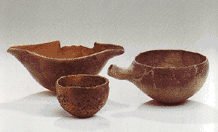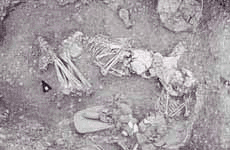BurialsPrehistoric BurialsExtensive excavations in Wadi Halfa, in Sudan,1 lead to the discovery of what is arguably the oldest evidence for human settlers in the Nile Valley, which was dated to the Paleolithic Age (Qadan- 13000-8000 BC). Other Paleolithic sites were located in the south of Lower Nubia including in Toshka and Gebel Sahaba.2 In Toshka, domesticated wild cattle were put on top of many of the burials, indicating the practice of a certain ritual. The burial pits were mostly circular, which perhaps lead to the building of the mound structure. However, in most of the sites the deceased had no specific body orientation although contracted positioning was common. No other significant finds were recovered from the site so far.
In spite of the intensive archeology in Lower Nubia, no significant Neolithic graves were uncovered. The only Neolithic discoveries were found in central Sudan, particularly in Khartoum, Kadruka, Shabona, el Ghaba , and Kadero.3 However, the most important excavations were conducted in Khartoum. The excavations revealed a culture that dates back to about 6900 years ago.4 The discoveries point to the existence of a small settled village or a community in Khartoum. The bodies were contracted and laid on their backs, thus symbolizing birth. This was the first indication for the beginning of the religious concept that later became embodied in the Cult of Re, the sun god. The bodies were, for the most part, nude. Many burials contained pottery showing the first signs for mortuary offerings, which continued throughout the ancient history of Sudan. Not many burial goods were found except for some water mollusk shells from Khartoum, some ostrich feathers (for head decoration), and other few toilet ornaments. In Kadero and el Ghaba, large cemeteries were discovered outside of their settlements. Dating to the Neolithic period, in el Ghaba, considerable amounts of circular or sub-circular pits (diameters varying from 120cm to 160cm) were found. There, the bodies were adorned with personal commodities like bracelets and necklaces, lip-plugs, stone and bone tools, pottery, ostrich feathers, and water mollusc shells. Clothes made of natural local materials, headrests and footrests, and traces of facial painting (i.e. perhaps an indication of tribal identity) were found. The finding of mollusk shells, probably obtained from the Red Sea, represents one of the world's earliest evidence for human trade and exchange.
From these graves we start to see the early formation of the Kushite culture taking shape. The habit for burying in circular pits continues throughout Sudan's ancient history starting from that of Kerma, disappearing in the Napatan and Merioitic period, and re-appearing in the Post-Meroitic era. Slight differences in burials in Kadero, indicate the formation of different communal identities. For example, the bodies were found contracted; however, on their sides. Differences in material goods assert the accuracy of the assumption. Pillows and mats, fragments of malachite, and vases are among the grave findings. The graves of Kadero are the earliest of its kind to indicate the practice of animal sacrifice. There, pieces of animal bones (i.e. of dogs) were found. This tradition of animal sacrifice continued throughout ancient Sudan's history as a distinguished tradition. Child burials in bucrania and large vessels were also common, indicating a special concern on the subject of maturity. Human sacrifices were also discovered in el-Kadada.
Edited: Dec. 2008. |

